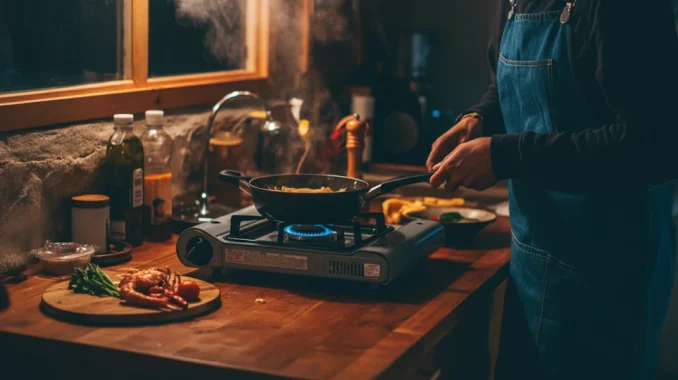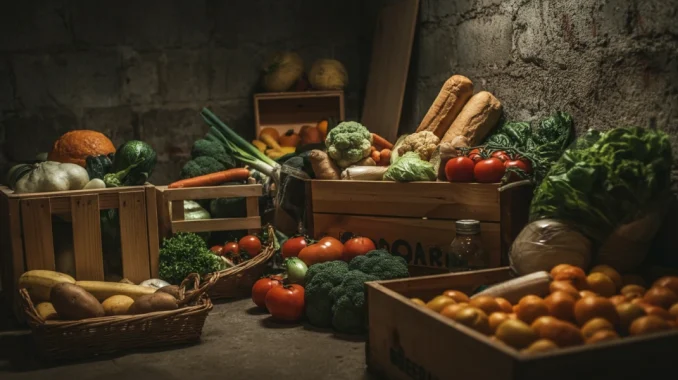During times of war, conflict, or economic instability, access to electricity and refrigeration can become unreliable. Preserving food without a refrigerator is an essential survival skill, ensuring that meat, dairy, and vegetables remain edible for long periods. Traditional preservation techniques like smoking, drying, canning, and pickling have been used for centuries to store food safely without modern appliances. These methods can be invaluable when facing supply chain disruptions, power outages, or when living off-grid.
This guide will teach you how to preserve meat, dairy, and vegetables using simple, effective techniques that require little to no electricity. You’ll also learn what to avoid to prevent spoilage and foodborne illnesses.

Preserving Meat Without Refrigeration
Meat spoils quickly if not properly stored. Below are some of the best ways to keep it safe for long-term use.
Smoking Meat
Smoking is one of the oldest and most effective ways to preserve meat. It works by removing moisture, which bacteria need to grow, while also coating the meat in antibacterial smoke compounds that prevent spoilage. This method not only preserves meat but also enhances its flavor.
To smoke meat effectively, start by selecting the right type of meat. Beef, pork, fish, and poultry are the best options. Before smoking, the meat should be generously salted. Salt helps to draw out moisture and acts as a natural preservative. Once salted, the meat should be placed in a well-ventilated smoking area where it can be exposed to slow-burning hardwood smoke. The best types of wood to use include oak, hickory, or cherry, as they provide a strong, flavorful smoke that helps with preservation.
The smoking process should be done at a low temperature, ideally between 50–80°C (120–175°F). Smoking can take anywhere from several hours to multiple days, depending on the thickness of the meat and the desired dryness. The longer the smoking process, the better preserved the meat will be. After smoking, store the meat in a dry, cool place. Wrapping it in paper or vacuum-sealing it can help extend its shelf life even further.
Drying (Dehydrating) Meat
Drying is another effective way to preserve meat, particularly in warmer climates where smoking may not be an option. Removing moisture from meat prevents bacteria and mold from growing, significantly extending its shelf life.
To dry meat, start by cutting it into thin slices. The thinner the slices, the faster they will dry. Salt or marinate the meat beforehand to add flavor and enhance preservation. Drying can be done in the sun, in an oven set to a very low temperature, or using a food dehydrator. The drying process can take from a few hours to several days, depending on the method used.
Once fully dried, store the meat in airtight containers, preferably vacuum-sealed, to keep moisture out. If stored correctly, dried meat can last for months and can be eaten as jerky or rehydrated in soups and stews.
Curing with Salt
Salt curing has been used for centuries as a method to preserve meat for long periods. The salt draws out moisture, preventing bacterial growth and spoilage. This method is especially useful for those who need to store meat without access to refrigeration.
To salt-cure meat, completely cover it with salt and let it sit in a cool, dry place for one to two weeks. The salt penetrates the meat, preserving it. After the curing period, rinse off the excess salt and hang the meat to dry. The drying period can last several weeks. Once dried, the meat can be stored for months and even years if kept in a dry and cool environment. To prepare salt-cured meat for eating, soak it in water or broth to remove excess salt before cooking.
Preserving Dairy Without Refrigeration
Dairy products spoil quickly, but with the right techniques, they can be preserved for extended periods.
Making Hard Cheese
Hard cheeses last much longer than soft cheeses and are easier to store without refrigeration. Making cheese at home is a skill that ensures a steady supply of dairy even in difficult conditions.
To make hard cheese, start by heating milk and adding rennet or vinegar, which causes the milk to curdle. Once curds form, separate them from the whey and press them into a mold. Salt is then added to help preserve the cheese and enhance its flavor. The cheese should be left to age in a cool, dry place for weeks or months. Wrapping the cheese in wax or cloth will prevent it from drying out too much and protect it from contamination.
Making Butter and Ghee
Butter can go rancid quickly, but ghee, which is clarified butter, lasts much longer and does not require refrigeration.
To make ghee, melt unsalted butter over low heat and allow it to cook until the milk solids separate from the liquid. Remove the milk solids and strain the liquid into an airtight jar. When stored in a cool, dry place, ghee can last for months or even years without spoiling.
Fermenting Milk into Yogurt
Fermenting milk into yogurt extends its shelf life while also making it easier to digest.
To make yogurt without refrigeration, heat milk to about 40-45°C (105-113°F) and add a small amount of yogurt with live cultures. Wrap the container in a towel and let it sit overnight in a warm place. Once thickened, store it in a cool, dry place. Fermented dairy products last much longer than fresh milk and provide valuable probiotics for digestion.
Preserving Vegetables Without Refrigeration
Vegetables are highly perishable, but several methods can extend their shelf life for months or even years.
Pickling
Pickling is one of the simplest and most effective ways to preserve vegetables without refrigeration. To pickle vegetables, choose fresh produce such as cucumbers, carrots, peppers, cabbage, or onions. Prepare a vinegar or salt brine solution, place the vegetables in sterilized jars, and pour the brine over them. Seal the jars tightly and store them in a cool, dark place. Pickled vegetables can last for months or even years when properly sealed.
Canning Vegetables
Canning is another great method for preserving vegetables long-term. Start by washing and chopping vegetables, then blanch them in boiling water for a few minutes. Place them in sterilized jars and fill with hot water or brine. Seal the jars and boil them to create a vacuum seal. Properly canned vegetables can last for one to five years.
Drying (Dehydration)
Drying vegetables removes moisture, preventing bacteria and mold growth. Slice vegetables into thin pieces, lay them in the sun, or use an oven set to a low temperature. Store dried vegetables in airtight containers. They can be rehydrated when needed for soups and stews.
Conclusion: Long-Term Food Security Without Refrigeration
By using these traditional preservation techniques, you can store food for months or even years without refrigeration. Whether preparing for war, supply shortages, power outages, or off-grid living, these methods will keep you and your family nourished.
Learn and practice these techniques before an emergency. Store preserved food in a cool, dry, and dark place. Always use clean hands and sanitized containers to prevent contamination. Rotate stock regularly to keep a fresh supply.
Food security is one of the most important survival skills—start preserving today!




